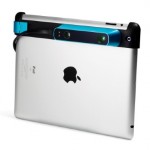As an employee of a company located on N.C. State’s Centennial Campus, I have access to the tech lending program of the N.C. State libraries. One of the more interesting devices I found there two weeks ago was a 3D scanner kit consisting of an iPad Air and an Occipital Structure 3D Sensor device. Not knowing much about it I thought I would take it home for a week and see what it could do.
The sensor integrates with the iPad by using the iPad’s built-in camera in conjunction with the Structure sensor. The sensor paints the scene in front of it with infrared grid points. The sensor then detects how this grid is bent by the object in the field and, together with the iPad’s sensitive accelerometers, computes the dimensions of the object. All of this happens in seconds and it’s quite amazing to watch!
Here’s how it works. Looking through the eyes of the app, you are given a virtual box which you adjust using finger swipes to encompass your object. Once the object is in “focus” (i.e., painted red in your image), you click the start button. Magically, the object’s image becomes coated with what looks like grey modeling clay as the software captures the object’s dimensions. As you slowly wave the iPad up and down and around the object, the gaps fill in to where the object appears thoroughly “coated” in the screen. After about 2 minutes or so (if your subject is a human, for instance) all the visible gaps are filled in and you hit the stop button to complete your scan.
The software then presents you with a three-dimensional rendering of your subject. Another button adds color captured by the iPad camera to present a frighteningly-detailed representation of your subject. You can then manipulate your subject on the screen in every which way using finger swipes. Saving the resulting model, though, can only be done by emailing it from the iPad. I could not find any way to download it through Bluetooth, USB, or the like.
After playing with the scanner for a week, creating representations of my home furniture, my family, my dog, and other interesting subjects, I came away impressed. The sensor runs about $400 and does a good job of creating models. The detail of the camera, however (as opposed to the scanner) leaves much to be desired, with detail of 640×480 pixels from what I understand. This color overlay, known as textures in the 3D model world, winds up looking less detailed than one would like. Also, the software is rather crude at this point. It’s still freakishly cool, though!
I can see all kinds of uses for such a device. For instance, whenever a crook might wander up to my door, a scanner could capture the exact dimensions of his face in seconds, without his knowledge. In fact, several scanners, placed in a public location, could quite quickly and accurately scan the faces of the general public without their knowledge. The resulting 3D models could be used in all kinds of scenarios, some good and some not so good.
Am I concerned? Not really. By now so many photos of me have been tagged on Facebook that anyone who wants it already has enough fodder to build a 3D model of me. But it is important to consider how this technology might be used in ways we aren’t yet considering.
I hope to borrow the Structure again soon to add more models to my collection. Then when my Blender skills improve I’ll have some quick and dirty familiar objects with which to stock my scenes.

